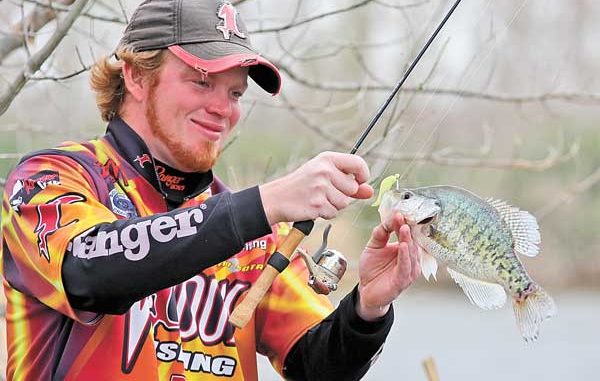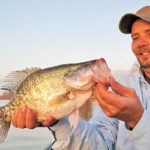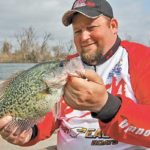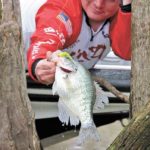
Can’t catch crappie in the hot summer? You will using this technique.
I remember watching Hank Parker fishing with a spincast rod and reel on his television show several years ago. He was fishing for crappie, and he claimed that using the push-button reel and limber rod allowed him to present his jig to fish that were virtually unmolested right in the middle of a bustling lake.
He was grabbing his bait in his left hand and pulling it back so much that it forced his rod to bow under the pressure. With his other thumb on the push button, he released the bait while releasing the button a split second later, and his jig skipped about 20 feet up under the dock.
I saw him reeling in several slab-sized crappie, but some fancy television editing and a few well-timed cuts made me wonder if he was really catching fish that way, or if his production crew was a master of special effects.
Last year I found myself sharing a boat with professional crappie angler Travis Bunting. We were exploring some different ways of catching crappie, and after several failed attempts at slow-trolling, pulling crankbaits and long-lining, he reached into his rod box and pulled out a reel that looked like it came from Toys R Us.
It was only 5 1/2 feet long, and it had the tiniest spinning reel on it. The rod’s questionable masculinity didn’t faze Bunting as he picked it up, grabbed the chartreuse jig in his left hand, pulled it back and let it go in the blink of an eye.
The jig hit the water about 10 feet out from his boat and skipped two or three times until it disappeared in the darkest recesses of the dock we were fishing. He flipped the bail, held the rod tip still and made me a believer in Hank Parker.
“Will that work in Louisiana?” I asked.
“Y’all go on any lakes with docks,” he rhetorically asked. “I’m sure y’all do, so I’m sure shooting docks for crappie will work.”
According to Bunting, shooting docks is catching on all across the United States because it allows crappie anglers to present their jigs into places where crappie rarely see a man-made bait.
Like hunting 100 yards off a wildlife management area access road will yield little to no deer, fishing on the edge of a dock will yield little to no crappie. Sure, there are times when they come out to the edge, but they are far more likely to be way back under a dock than they are hanging out on the edges.
However, since very few Louisiana anglers shoot docks for crappie, Bunting said anybody who gives it a try this summer would more than likely find crappie in as little as 5 feet under a dock.
“That’s because they aren’t used to seeing a bait presented this way,” Bunting said. “When I first started shooting docks before lots of other people were doing it, they weren’t very far back. Now, they’re back in there 20 to 25 feet under the docks because more and more anglers are catching on to shooting docks.”
So the timing is setting up quite nicely for interested crappie anglers to start shooting docks here in Louisiana. Not only are crappie under shady docks right now, they aren’t so far back in the shade that inexperienced dock shooters can’t reach them. In other words, you can practice and catch at the same time.
Bo Hudson is a crappie guide and crappie tournament angler. He is also a dock shooter. He knows first hand that the technique works in the oxbow lakes up and down the Mississippi River.
Many of the oxbow lakes on the Louisiana and Mississippi sides of the river are lined with docks where crappie seek shade during the summer. And when he goes out crappie fishing, he makes shooting docks a priority rather than an afterthought.
“How many people do you see fishing off their docks,” Hudson asked. “Think about what they’re doing. They’re fishing the edge out to where your boat is usually sitting when you’re fishing their dock. With dock shooting, you can put a bait under where they’re standing, and that’s where most of the crappie are.”
How thick do the crappie get back under the docks? According to Bunting, he’s caught crappie under docks that actually had rub spots on the backs of their heads because they were suspended in such tightly packed schools.
“It’s all about the shade,” Bunting said. “Any time you have high sun, the fishing is good under the docks. Next time you’re fishing a dock, look under there, and you’ll see a few different shades of shade. Some spots are lighter than others. And some stand out because they are way darker than the other spots. Those are the spots you want to fish.”
To most effectively shoot a crappie jig under a dock, Bunting says it’s important to take a low profile. In other words, get as low to the water as you can either by kneeling or sitting down in a boat seat.
It’s the same principle used when skipping rocks. Anybody throwing a rock from up high won’t get but one skip and a sinking rock. However, if you throw the rock from down low — sidearm it — it comes out on a lower trajectory that allows it to skip several times because the momentum is going forward parallel to the water’s surface rather than straight down into it.
“What you want to do is flip the bail on your spinning reel and grab the line coming off the spool with just your fingertips kind of like you were shooting a bow and arrow without a release,” Bunting instructed. “Then grab the bend of your jig hook in your other hand. Pull the jig straight back in a straight line with your rod. Aim and release the jig.”
During the summer, Bunting and Hudson say the best retrieve is to simply flip the bail on the spinning reel and hold the rod steady. Crappie will be suspended around 10 to 12 feet deep, and holding the rod steady will allow your jig to swing back to you through this zone.
“In winter, you might want to let it go to bottom and hop it a few times,” Hudson said. “During the spring, you might want to flip the bail and start reeling as soon as it hits the water because the fish are up shallow. But in the summer, you’ve got to let it swing through the fish, which are neither on the surface nor on the bottom.”
A key to getting lots of bites during the summer is to fish a big-bodied jig on a light jighead so that it swims slowly through suspended crappie. That’s why Hudson uses a plump jig like a Bobby Garland Baby Shad rigged on a 1/16- or 1/32-ounce jig. A simple design like the Baby Shad also skips easier than other plastics that may have multiple appendages.
The only problem with allowing a jig to pendulum through crappie under a dock is that the inevitable bow created in your line means that you’d feel fewer of the light bites because the slack line absorbs much of the feeling.
“You’ve to be a line watcher when you shoot docks during the summer,” Bunting said. “Spool up with a line you can see. I’ve been using the 6-pound-test Hi-Vis Vicious panfish line. Any bright line like this will help you see it jump right where it enters the water when you get bit.”
As Bunting finished talking about shooting docks, he concluded with the suggestion that anglers don’t give up when first trying this new technique. It’s easy to get frustrated and never try it again when your jigs aren’t skipping and are hanging up on everything above the water rather than falling below it.
“Stay with it,” Bunting advised. “You may not get it at first, but it’s a feel thing. The more you practice it, the better you’re going to get. It’s definitely not something you’re going to be able to perfect your first two or three trips, but you’ll get the hang of it after a while.”
Had I not watched Bunting shooting docks with my own eyes, I might still believe that Hank Parker was using some fancy television editing to make himself look good.
Now, I know that shooting docks is an extremely productive technique for catching crappie in places where others either fear to fish, or just don’t want to be bothered with all the extra effort required.
Extra effort will pay off whether you’re way off the access road at your local WMA or way under the docks at your local lake. Then you’ll be the one to congratulate rather than the one to complain.






